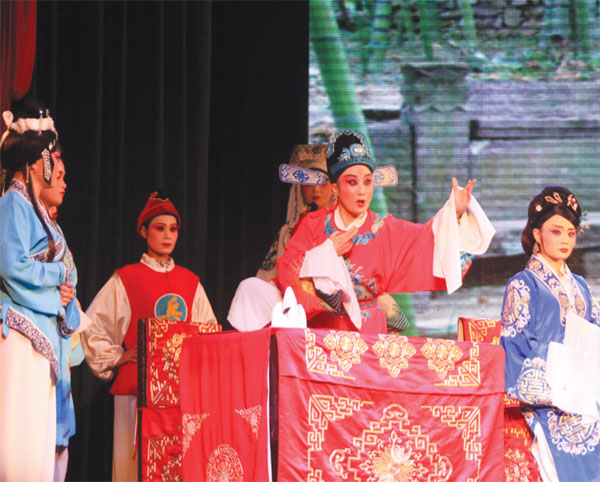China folklife coming to the National Mall in late June
By Chen Weihua (China Daily USA) Updated: 2014-06-04 11:01
If you are curious about the art, culture and food traditions in China, but cannot afford the time or money to travel that far to learn about it, then head to the National Mall in Washington for the 48th annual Smithsonian Folklife Festival, where China will be on center stage.
From June 25-29 and July 2-6, the festival, which is free and usually draws some 1 million visitors each year, will present living traditions of China.
China: Tradition and the Art of Living will feature 120 artists and artisans highlighting the diversity among the country's distinct communities. Musicians, dancers, craftspeople and cooks will show how the Chinese, despite current change and pressures, are working to preserve and adapt their traditional culture, according to the Smithsonian Institution.
|
Wu Opera is one of the Chinese traditional performances set for the Smithsonian Folklife Festival. Asia News Photo |
Li Hong, minister counselor for culture at the Chinese embassy in Washington, described the upcoming event as the largest of its kind from China in recent years. She said preparations have been under way for the past three years in collaboration with US counterparts. "People will get to know how Chinese folk life and cultural heritage have been passed down from generation to generation, preserved and enhanced," she said.
Li is confident the colorful program will be well received by the public.
"I hope our visitors this year will leave with a better understanding of the diversity of China by meeting and learning from our participants, who come from 15 regions and represent some of China's 56 ethnicities," said program co-curator Jim Deutsch.
Two themes - reunion and balance - will highlight the importance of seasonal festival traditions. Festival visitors can watch craftspeople make paper cuts, New Year's prints, clay figurines, kites and sachets that are used during annual celebrations and see artists who specialize in embroidery, patchwork, batiks and porcelain. Many of the items will be for sale in the festival's marketplace.
"People in the United States tend to be familiar with only certain aspects of Chinese culture - especially through film, food and Chinatowns," said program co-curator Sojin Kim. "Visitors will see things at the festival that are both familiar and unexpected. We hope that when they meet the participants and see their creativity and skills, it will transform how they consider art and culture that is 'made in China.'"
Visitors to China: Tradition in the Art of Living will also experience the exuberance of public life in China when they visit the People's Park area of the program. Participants will demonstrate and teach the flower-drum lantern dance, tai chi and water calligraphy, giving visitors a sense of the energy of Chinese public parks.
The Five Spice Kitchen area will show that food traditions in China are diverse and full of symbolism. Visitors will learn how foods like noodles and dumplings are prepared and served, and what roles certain dishes play in Chinese communities.
Food from China is often quite different from the Chinese food people are used to in the US. So many Chinese, who find it hard to get authentic Chinese food, are expected to rush to the National Mall to satisfy their taste buds, even though the festival venue, between 7th and 14th streets on the National Mall is only several blocks from Chinatown.
Visitors will also see a flower plaque, a decorative bamboo structure that celebrates the culture of southern China. People can visit the Moonrise Pavilion and see daily theater, song and dance performances by groups, including the Wu Opera Troupe and the Quanzhou Puppet Troupe.
While the Wu Opera Troupe will also perform with their Dragon Lion Cart, which is operated by a dozen performers, nearby, visitors of all ages can fly a kite or visit the family style tent to try Chinese calligraphy, play a game, learn Chinese phrases or dances.
In addition to China, Kenya will be another country that will be in the spotlight in this year's festival. The festival, inaugurated in 1967, often features one or several countries a year. Last year's highlight was about the tradition in Hungary. Chinese only sent small art troupes to the festival in previous years.
While the weather could be hot and sultry in Washington in late June and early June, you do want to dress as comfortable despite the fact that most activities will be held in huge tents.
The festival will be open every day from 11am until 5:30 pm; special evening events will begin at 6 pm. A detailed schedule is expected to be posted on the Smithsonian Folklife Festival website before the start of the festival.
Contact the writer at chenweihua@chinadailyusa.com










